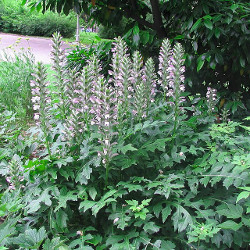« Acanthaceae » : différence entre les versions
Aucun résumé des modifications |
Aucun résumé des modifications |
||
| (6 versions intermédiaires par le même utilisateur non affichées) | |||
| Ligne 1 : | Ligne 1 : | ||
{{InfoboxFamille}} | {{InfoboxFamille| | ||
| Image= Acanthus mollis.jpg | |||
| Legende= Acanthus mollis | |||
| Regne= ''Plantae'' | |||
| Groupe= [[Angiospermes]] | |||
| Embranchement= [[Tracheophyta]] | |||
| Classe= [[Magnoliopsida]] | |||
| Ordre= [[Lamiales]] | |||
| Famille= [[Acanthaceae]] | |||
| OrdrePh= | |||
| FamillePh= | |||
}} | |||
__notoc__ | |||
La famille Acanthaceae fait partie du groupe principal des [[angiospermes]] (plantes à fleurs). | La famille Acanthaceae fait partie du groupe principal des [[angiospermes]] (plantes à fleurs). | ||
Les Acanthaceae (Acanthacées) sont une famille de plantes dicotylédones ; elle comprend au moins 4000 espèces réparties en près de 250 genres. | Les Acanthaceae ([[Acanthacées]]) sont une famille de plantes dicotylédones ; elle comprend au moins 4000 espèces réparties en près de 250 genres. | ||
Ce sont des plantes herbacées, des arbustes ou rarement des arbres. Ces plantes, parfois grimpantes ou épiphytes, sont répandues dans les régions tempérées à tropicales. On les rencontre principalement en Inde, Malaisie, Afrique, Brésil et Amérique centrale. | Ce sont des plantes herbacées, des arbustes ou rarement des arbres. Ces plantes, parfois grimpantes ou épiphytes, sont répandues dans les régions tempérées à tropicales. On les rencontre principalement en Inde, Malaisie, Afrique, Brésil et Amérique centrale. | ||
== Liste des espéces == | |||
===== A ===== | ===== A ===== | ||
| Ligne 123 : | Ligne 137 : | ||
[[Catégorie:Wikiplante]] | [[Catégorie:Wikiplante]] | ||
[[Catégorie: | [[Catégorie:Familles botaniques]] | ||
Version actuelle datée du 12 novembre 2024 à 13:10
| Acanthaceae | |
|---|---|
 Acanthus mollis Acanthus mollis
| |
| Classification classique | |
| Règne : | Plantae |
| Groupe : | Angiospermes |
| Embranchement : | Tracheophyta |
| Classe : | Magnoliopsida |
| Ordre : | Lamiales |
| Famille : | Acanthaceae |
| Liens internes | |
| Autres Liens Utile | |
La famille Acanthaceae fait partie du groupe principal des angiospermes (plantes à fleurs).
Les Acanthaceae (Acanthacées) sont une famille de plantes dicotylédones ; elle comprend au moins 4000 espèces réparties en près de 250 genres.
Ce sont des plantes herbacées, des arbustes ou rarement des arbres. Ces plantes, parfois grimpantes ou épiphytes, sont répandues dans les régions tempérées à tropicales. On les rencontre principalement en Inde, Malaisie, Afrique, Brésil et Amérique centrale.
Liste des espéces[modifier]
A[modifier]
Acanthopale - Acanthopsis - Acanthus - Achyrocalyx - Afrofittonia - Ambongia - Ancistranthus - Andrographis - Angkalanthus - Anisacanthus - Anisosepalum - Anisostachya - Anisotes - Anomacanthus - Aphanosperma - Aphelandra - Ascotheca - Asystasia - Avicennia
B[modifier]
Ballochia - Barleria - Barleriola - Blepharis - Borneacanthus - Boutonia - Brachystephanus - Bravaisia - Brillantaisia - Brunoniella
C[modifier]
Calacanthus - Calycacanthus - Camarotea - Carlowrightia - Celerina - Cephalacanthus - Cephalophis - Chalarothyrsus - Chamaeranthemum - Chileranthemum - Chlamydacanthus - Chlamydocardia - Chorisochora - Chroesthes - Clarkeasia - Clinacanthus - Clistax - Codonacanthus - Conocalyx - Cosmianthemum - Crabbea - Crossandra - Crossandrella - Cyclacanthus - Cynarospermum - Cyphacanthus - Cystacanthus
D[modifier]
Danguya - Dasytropis - Dicladanthera - Dicliptera - Dischistocalyx - Dolichostachys - Duosperma - Duvernoia - Dyschoriste
E[modifier]
Ecbolium - Echinacanthus - Elytraria - Encephalosphaera - Eranthemum - Eremomastax
F[modifier]
Filetia - Fittonia - Forcipella
G[modifier]
Geissomeria - Glossochilus - Graptophyllum - Gymnophragma - Gymnostachyum - Gypsacanthus
H[modifier]
Hansteinia - Haplanthodes - Haplanthus - Harpochilus - Hemigraphis - Henrya - Herpetacanthus - Heteradelphia - Holographis - Hoverdenia - Hulemacanthus - Hygrophila - Hypoestes
I[modifier]
Ichthyostoma - Isoglossa - Isotheca
J[modifier]
K[modifier]
Kalbreyeriella - Kosmosiphon - Kudoacanthus
L[modifier]
Lankesteria - Lasiocladus - Leandriella - Lepidagathis - Leptosiphonium - Linariantha - Louteridium
M[modifier]
Mackaya - Marcania - Megalochlamys - Megaskepasma - Melittacanthus - Mellera - Mendoncia - Mexacanthus - Meyenia - Mimulopsis - Mirandea - Monothecium
N[modifier]
Nelsonia - Neriacanthus - Neuracanthus
O[modifier]
Odontonema - Oplonia - Orophochilus
P[modifier]
Pachystachys - Pararuellia - Pericalypta - Petalidium - Phaulopsis - Phialacanthus - Phlogacanthus - Physacanthus - Podorungia - Poikilacanthus - Populina - Pranceacanthus - Pseuderanthemum - Pseudocalyx - Pseudodicliptera - Pseudosiphonium - Psilanthele - Ptyssiglottis - Pulchranthus
R[modifier]
Razisea - Rhinacanthus - Rhombochlamys - Ritonia - Ruellia - Ruelliopsis - Rungia - Ruspolia - Ruttya
S[modifier]
Saintpauliopsis - Salpixantha - Samuelssonia - Sanchezia - Sapphoa - Satanocrater - Schaueria - Schaueriopsis - Sclerochiton - Sebastianoschaueria - Spathacanthus - Sphacanthus - Sphinctacanthus - Stachyacanthus - Staurogyne - Stenandriopsis - Stenandrium - Stenostephanus - Stenothyrsus - Streblacanthus - Streptosiphon - Strobilacanthus - Strobilanthes - Strobilanthopsis - Suessenguthia
T[modifier]
Tabascina - Tessmanniacanthus - Tetramerium - Thunbergia - Thyrsacanthus - Thysanostigma - Trichanthera - Trichaulax - Trichocalyx - Trichosanchezia
V[modifier]
W[modifier]
X[modifier]
Xantheranthemum - Xerothamnella - Xylacanthus